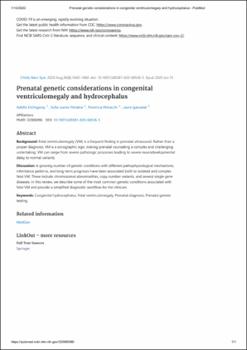Prenatal genetic considerations in congenital ventriculomegaly and hydrocephalus
| dc.contributor.author | Etchegaray, Adolfo. | |
| dc.contributor.author | Juarez-Peñalva, Sofía. | |
| dc.contributor.author | Petracchi, Florencia. | |
| dc.contributor.author | Igarzabal, Laura. | |
| dc.date.accessioned | 2020-10-01T21:21:36Z | |
| dc.date.available | 2020-10-01T21:21:36Z | |
| dc.date.issued | 2020-08-31 | |
| dc.identifier.citation | Childs Nerv Syst 36, 1645–1660 (2020). | en_US |
| dc.identifier.issn | 1433-0350 | |
| dc.identifier.uri | https://riu.austral.edu.ar/handle/123456789/972 | |
| dc.description.abstract | Abstract Background: Fetal ventriculomegaly (VM) is a frequent finding in prenatal ultrasound. Rather than a proper diagnosis, VM is a sonographic sign, making prenatal counseling a complex and challenging undertaking. VM can range from severe pathologic processes leading to severe neurodevelopmental delay to normal variants. Discussion: A growing number of genetic conditions with different pathophysiological mechanisms, inheritance patterns, and long-term prognosis have been associated both to isolated and complex fetal VM. These include chromosomal abnormalities, copy number variants, and several single gene diseases. In this review, we describe some of the most common genetic conditions associated with fetal VM and provide a simplified diagnostic workflow for the clinician. | en_US |
| dc.language.iso | en | en_US |
| dc.publisher | Springer | en_US |
| dc.subject | Congenital hydrocephalus | en_US |
| dc.subject | Fetal ventriculomegaly | en_US |
| dc.subject | Prenatal diagnosis | en_US |
| dc.subject | Prenatal genetic testing | en_US |
| dc.title | Prenatal genetic considerations in congenital ventriculomegaly and hydrocephalus | en_US |
| dc.type | Article | en_US |


